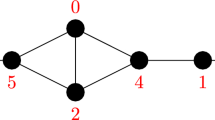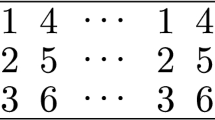Abstract
The limited connectivity of current and next-generation quantum annealers motivates the need for efficient graph minor embedding methods. These methods allow non-native problems to be adapted to the target annealer’s architecture. The overhead of the widely used heuristic techniques is quickly proving to be a significant bottleneck for solving real-world applications. To alleviate this difficulty, we propose a systematic and deterministic embedding method, exploiting the structures of both the specific problem and the quantum annealer. We focus on the specific case of the Cartesian product of two complete graphs, a regular structure that occurs in many problems. We decompose the embedding problem by first embedding one of the factors of the Cartesian product in a repeatable pattern. The resulting simplified problem comprises the placement and connecting together of these copies to reach a valid solution. Aside from the obvious advantage of a systematic and deterministic approach with respect to speed and efficiency, the embeddings produced are easily scaled for larger processors and show desirable properties for the number of qubits used and the chain length distribution. We conclude by briefly addressing the problem of circumventing inoperable qubits by presenting possible extensions of our method.










Similar content being viewed by others
Notes
It is worth mentioning that the ferromagnetic coupling between any two adjacent vertices should not be too strong. This is because the parameter range of the annealer is limited, so a very strong coupling will lead to a rescaling of the rest of the problem, which can prove detrimental.
This argument is due to Marshall Drew-Brook, and we would like to thank Aidan Roy for pointing it out to us.
References
Adler, I., Dorn, F., Fomin, F.V., Sau, I., Thilikos, D.M.: Faster parameterized algorithms for minor containment. Theor. Comput. Sci. 412(50), 7018–7028 (2011). doi:10.1016/j.tcs.2011.09.015. http://www.sciencedirect.com/science/article/pii/S0304397511007912
Alghassi, H.: The algebraic QUBO design framework. To be published
Bodlaender, H.L., Koster, A.M.: Treewidth computations i. upper bounds. Inf. Comput. 208(3), 259–275 (2010)
Boothby, T., King, A.D., Roy, A.: Fast clique minor generation in chimera qubit connectivity graphs. Quantum Inf. Process. 15(1), 495–508 (2016). doi:10.1007/s11128-015-1150-6
Cai, J., Macready, W.G., Roy, A.: A practical heuristic for finding graph minors. Preprint (2014). arXiv:1406.2741
Choi, V.: Minor-embedding in adiabatic quantum computation: \({\rm II}\). \({\rm M}\)inor-universal graph design. Quantum Inf. Process. 10(3), 343–353 (2011). doi:10.1007/s11128-010-0200-3
Dridi, R., Alghassi, H.: Homology computation of large point clouds using quantum annealing. Preprint (2015). arXiv:1512.09328
Fan, N., Pardalos, P.M.: Linear and quadratic programming approaches for the general graph partitioning problem. J. Glob. Optim. 48(1), 57–71 (2010). doi:10.1007/s10898-009-9520-1
Godsil, C., Royle, G.: Algebraic Graph Theory, Volume 207 of Graduate Texts in Mathematics (2001)
Grohe, M., Marx, D.: On tree width, bramble size, and expansion. J. Comb. Theory Ser. B 99(1), 218–228 (2009)
Hager, W.W., Krylyuk, Y.: Graph partitioning and continuous quadratic programming. SIAM J. Discret. Math. 12(4), 500–523 (1999)
Hernandez, M., Zaribafiyan, A., Aramon, M., Naghibi, M.: A novel graph-based approach for determining molecular similarity. Preprint (2016). arXiv:1601.06693
Imrich, W., Peterin, I.: Recognizing \({\rm C}\)artesian products in linear time. Discret. Math. 307(3–5), 472–483 (2007)
Johnson, M.W., Amin, M.H.S., Gildert, S., Lanting, T., Hamze, F., Dickson, N., Harris, R., Berkley, A.J., Johansson, J., Bunyk, P., Chapple, E.M., Enderud, C., Hilton, J.P., Karimi, K., Ladizinsky, E., Ladizinsky, N., Oh, T., Perminov, I., Rich, C., Thom, M.C., Tolkacheva, E., Truncik, C.J.S., Uchaikin, S., Wang, J., Wilson, B., Rose, G.: Quantum annealing with manufactured spins. Nature 473(7346), 194–198 (2011)
Kaminsky, W., Lloyd, S.: Scalable architecture for adiabatic quantum computing of \(\rm NP\)-hard problems. In: Leggett, A., Ruggiero, B., Silvestrini, P. (eds.) Quantum Computing and Quantum Bits in Mesoscopic Systems, pp. 229–236. Springer, New York (2004). doi:10.1007/978-1-4419-9092-1_25
Kaplansky, I., Riordan, J.: The problem of the rooks and its applications. Duke Math. J. 13(2), 259–268 (1946). doi:10.1215/S0012-7094-46-01324-5
King, A.D., Lanting, T., Harris, R.: Performance of a quantum annealer on range-limited constraint satisfaction problems. Preprint (2015). arXiv:1502.02098
Lucena, B.: Achievable sets, brambles, and sparse treewidth obstructions. Discret. Appl. Math. 155(8), 1055–1065 (2007)
Pardalos, P.M., Mavridou, T., Xue, J.: Handbook of Combinatorial Optimization: volume 2, chap. The Graph Coloring Problem: A Bibliographic Survey, pp. 1077–1141. Springer, Boston (1999). doi:10.1007/978-1-4613-0303-9_16
Perdomo-Ortiz, A., Fluegemann, J., Biswas, R., Smelyanskiy, V.N.: A performance estimator for quantum annealers: gauge selection and parameter setting. Preprint (2015). arXiv:1503.01083
Perdomo-Ortiz, A., O’Gorman, B., Fluegemann, J., Biswas, R., Smelyanskiy, V.N.: Determination and correction of persistent biases in quantum annealers. Sci. Rep. 6, 18628 (2016)
Rieffel, E.G., Venturelli, D., O’Gorman, B., Do, M.B., Prystay, E.M., Smelyanskiy, V.N.: A case study in programming a quantum annealer for hard operational planning problems. Quantum Inf. Process. 14(1), 1–36 (2014). doi:10.1007/s11128-014-0892-x
Rieffel, E.G., Venturelli, D., O’Gorman, B., Do, M.B., Prystay, E.M., Smelyanskiy, V.N.: A case study in programming a quantum annealer for hard operational planning problems. Quantum Inf. Process. 14(1), 1–36 (2015)
Seymour, P.D., Thomas, R.: Graph searching and a min–max theorem for tree-width. J. Comb. Theory Ser. B 58(1), 22–33 (1993)
Thomas, R.: Tree-decompositions of graphs (lecture notes). School of Mathematics. Georgia Institute of Technology, Atlanta, 30332 (1996)
Venturelli, D., Mandrà, S., Knysh, S., O’Gorman, B., Biswas, R., Smelyanskiy, V.: Quantum optimization of fully connected spin glasses. Phys. Rev. X 5, 031040 (2015). doi:10.1103/PhysRevX.5.031040
Venturelli, D., Marchand, D.J.J., Rojo, G.: Quantum annealing implementation of job-shop scheduling. Preprint (2015). arXiv:1506.08479
Young, K.C., Blume-Kohout, R., Lidar, D.A.: Adiabatic quantum optimization with the wrong Hamiltonian. Phys. Rev. A 88, 062314 (2013). doi:10.1103/PhysRevA.88.062314
Acknowledgements
The authors are grateful to Marko Bucyk for editing the manuscript, to Brad Woods, Natalie Mullin, Abbas Mehrabian, and Robyn Foerster for useful discussions and input, and to Aidan Roy for providing useful information on the treewidth of Chimera graphs. This work was supported by Mitacs (Grant No. IT03226).
Author information
Authors and Affiliations
Corresponding author
Ethics declarations
Conflict of interest
The authors are employees of 1QBit, a company that has quantum software as one of its areas of focus. D-Wave Systems is a minority investor in 1QBit.
Rights and permissions
About this article
Cite this article
Zaribafiyan, A., Marchand, D.J.J. & Changiz Rezaei, S.S. Systematic and deterministic graph minor embedding for Cartesian products of graphs. Quantum Inf Process 16, 136 (2017). https://doi.org/10.1007/s11128-017-1569-z
Received:
Accepted:
Published:
DOI: https://doi.org/10.1007/s11128-017-1569-z




